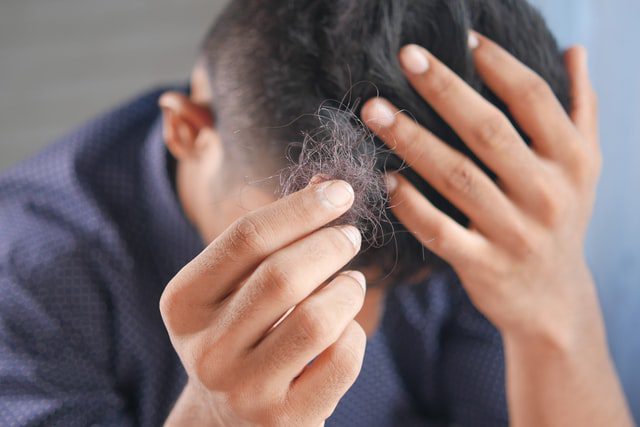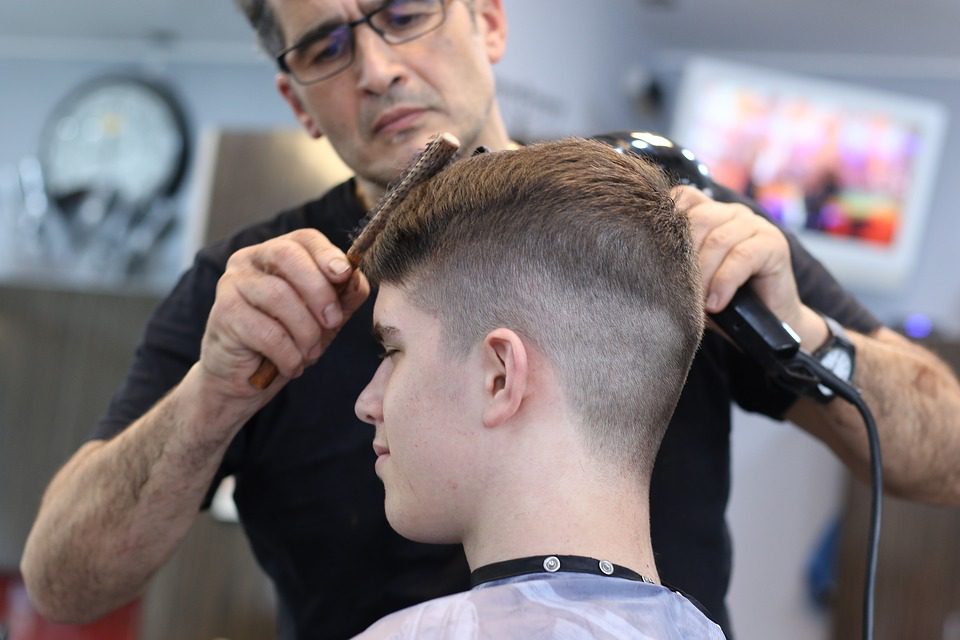
Hair Loss In Trans Men
Countless men around the world are facing severe hair loss issues. Although this is never a desirable experience, trans men experience some very specific and particularly difficult challenges regarding hair growth.
The most common form of hair loss is known as androgenic alopecia. This condition is hormone-related, and managing its complications in conjunction with hormone replacement therapy can be problematic.
Androgenic alopecia is more commonly referred to as male pattern baldness. Its equivalent condition, female pattern baldness, is much less prevalent, and men are usually the most affected.
An astonishing 30% of American men will experience the onset of male pattern baldness by age 35. Furthermore, 50% will notice significant hair thinning and a receding hairline by the time they are 50.
Androgenetic alopecia is initiated by the susceptibility to dihydrotestosterone. This hormone causes hair follicles to become lighter in color, narrower in diameter, and shorter in length.
There are a few options worth considering in the treatment of this condition. One option is the use of finasteride, which blocks or slows DHT production and thereby also the progression of hair loss.

The Basic Of Hair And Hair Loss
It is helpful to understand hair growth patterns before attempting to comprehend why and how hair loss occurs.
Each hair strand, or shaft, consists of an extremely strong protein called keratin. Keratin is also the structural protein that makes up our nails and the outermost layer of our skins.
Healthy, strong facial hair, hair on our heads, armpits, and pubic areas are caller „terminal hair.“ In contrast, hair that is very light in color, fine, and thin is referred to as „vellus hair.“
The three layers of a hair shaft are the medulla, the cortex, and the cuticle.
The cuticle is the colorless outer layer that forms an impenetrable cover of overlapping scales protecting our hair from environmental factors.
The middle layer, the cortex, provides elasticity, strength, color, and texture to our hair.
The innermost layer of the hair is the medulla. This layer is only present in thicker hair, such as the hair on our heads.
A follicle is a small sac-like canal that hair grows out of. The bottom of the follicle is a bulbous area termed the dermal papilla. This is the area where the hair fiber is first produced.
The dermal papilla receives its nourishment from tine blood vessels. Hair follicles are connected to oil-producing glands called sebaceous glands along with arrector pili, which are the small muscle fibers that raise our hair.
The hair growth cycle occurs in three phases: the anagen phase, catagen phase, and telogen phase.
Hair typically resides in the anagen phase 90% of the time and can remain there for up to 6 years. This is the growth phase, and hair grows approximately 10cm yearly.
Next, hair enters the catagen phase, which is a transitional phase lasting around two weeks. During this phase, the hair follicles shrink substantially before being completely destroyed.
The dermal papilla then breaks away and goes to rest under the follicle.
The telogen phase is also called the resting phase. This normally endures for around six weeks. The hair does not grow during this phase but stays adhered to the follicle.
After the telogen phase, the follicle reinstates the anagen phase. The dermal papilla rejoins the bottom of the follicle after having rested since the end of the catagen phase. The old hair is either shed or pushed out by the new hair.
Each hair shaft undergoes this cycle regardless of what the hair around it is doing. The average person sheds up to 100 hairs daily. Shedding is normally not noticeable due to new hairs emerging at a constant rate.
Androgenetic alopecia arises when the body fails to grow new hairs on specific areas of the scalp. This is a gradual and slow process that is not generally strikingly noticeable in its initial phases.

Hair Loss In Trans Men
Hormone replacement therapy for a trans man involves taking the hormones testosterone and DHT, which decreases estrogen levels.
This brings about secondary sex characteristics common in males. Higher testosterone levels lessen the magnitude of female characteristics of trans guys, which is commonly desirable.
Taking testosterone can greatly contribute to the success of a transition for trans men. Nevertheless, DHT is directly associated with hair loss and androgenetic alopecia, which presents more complicated challenges for trans men than for cis men.
A receding hairline and signs of balding do not affect most men in the same way it affects trans men.
Hormone therapy is a tool to express your true identity, and hair loss is an unfortunate consequence that could be detrimental to the mental health and self-confidence of trans people.
Drugs like finasteride could aid in decreasing the contribution of DHT to hair loss, and in many cases, it has proven successful effectiveness. However, there’s a catch.
Taking finasteride may interfere with the effect of testosterone. Each person’s personal experience will vary, but some trans men have even reported regaining their menstrual cycle after taking finasteride or Propecia aiming to reduce hair loss.
The return of female sex characteristics is significantly harmful to the well-being and mental health of a trans man. It may worsen the anxiety associated with gender dysphoria.
Many trans men have experienced satisfactory results when they attempt to find a golden mean. They continue taking testosterone for as long as it takes to develop the desired masculine sex characteristics before addressing the issue of hair loss.
Once they reach a point where they feel content with their transition, they start administering finasteride or Propecia with the goal of minimizing hair loss.
Finasteride Alternatives
If a trans man notes that finasteride is decreasing desired effects of testosterone and related hormones commonly involved in FTM transitions, he could turn to minoxidil.
Minoxidil is commercially referred to as Rogaine and was initially intended to treat high blood pressure.
It was later realized that this drug facilitates hair growth. Minoxidil can be very beneficial to a transgender man in that it increases blood flow to hair follicles, thereby stimulating new hair generation and growth.
It is recommended that trans men consult a doctor before commencing treatment with alternative supplements. A doctor is able to provide quality advice based on your individual physiology, transition goals, and family history.
It is also important to note that minoxidil will not reverse balding but can only slow the progression of hair loss.
How Far Into Testosterone Treatment Will Hair Loss Be Evident?
The effects that hormones will have on hair growth will vary between guys. To explore common findings, we will consider some personal experiences that users of Quora and Reddit have made known.
Asher Selvaggio
Asher reported noticing the first signs of hair loss within six months of taking testosterone. His hair is naturally very thick, so he was far from becoming bald, but his hairline receded a bit. After the first six months of using testosterone, his hair stopped thinning and remained at a relatively stable thickness. He notes that this is primarily due to his genetic makeup, as both his mother and father have naturally thick hair. Asher was satisfied with his results because even though he experienced hair loss to a minor extent, he was left with a more masculine-looking hairline.
Martin Russo
Russo started losing his hair after four years of testosterone treatment. He said it was a slow process that was mostly limited to the top section of his scalp. Three decades after his transition, Martin reports having very little hair on the top of his head, but he retained most of the hair on the sides.
Javatimes
This Reddit user speaks out about the considerations involved in hair loss due to testosterone treatment. According to Javatimes, trans men should not be discouraged when they start balding as it is extremely prevalent among cis men as well. He reports losing some of his hair during the first few months on testosterone, but the process slowing with time. Javatimes claims that hair loss results in masculinization of the hairline, changing it from. a U shape to a more square shape.

Herbs And Vitamins As Hair Loss Treatment
Numerous herbal and vitamin treatments are freely available on the market. The research regarding their effectiveness in treating androgenetic alopecia is unclear as of yet and differs between patients.
However, many trans men have reported experiencing an improvement in terms of balding when using specific substances.
If nothing else, vitamins undoubtedly support a healthy scalp and hair, among various other locations of the body. Being essential nutrients, vitamins raise the overall nutritional status and one’s quality of life.
The issue with such treatments is that there isn’t much regulation of these products, and the FDA considers them dietary supplements instead of drugs.
A drug is classified as an article meant to diagnose, treat, mitigate, or prevent diseases in the body. Drugs must undergo various phases of clinical studies to definitively determine their safety and effectiveness.
Many factors, such as possible interactions with substances in the body, are studied before a drug is approved for use. It is mandatory for manufacturers to ensure their drug is FDA approved before it can be made available to the public.
Dietary supplements, in contrast, do not have to be FDA-approved to be sold. Such supplements include minerals, vitamins, herbs, amino acids, metabolites, and other plant-derived substances.
Although it may seem harmless because these substances are naturally found in the body, there is a very fine line between having balanced ratios and exceeding healthy levels.
Because drugs are patentable substances, the companies performing them can recoup their research costs. Dietary supplements are found in nature, so they are nonpatentable. Therefore, research and testing costs cannot easily be recouped. These supplements are rarely given the same amount of attention when it comes to ensuring they are safe. Clinical testing is simply not a cost-effective approach and is entirely eliminated from the process as a result.
Because of these facts, it would be wise to conduct your own research before purchasing natural balding treatments. Investigate a large variety of data and testimonies, along with researching the active ingredients present in these supplements. Being bald is not enough reason to put your body in harm’s way.
Hair Restoration Surgery And Hair Transplants
Trans men experiencing hair loss and hair thinning may not always get the desired results from drug treatment. If they have some money to spare and make for a good candidate, hair restoration surgery may be the way to go.
Experts employ innovative micrografting techniques to create a natural-looking hairline with varying extents of hair loss. These services are available to cis men, cis women, trans men, and trans women.
This procedure poses exciting possibilities for those considering hair transplants as well as any male or female struggling with the devastating repercussions of becoming bald.
It is crucial that each patient watch for a well-trained and proficient surgeon in the latest developed techniques and equipment.
As crazy exciting as it is to consider creating a new hairline, finding a competent surgeon could be a daunting task. There is little to no regulation as to who is authorized to perform scalp surgery.
Any licensed physician or surgical doctor is technically allowed to do this without any requirements concerning accreditation.
This fact has many people worried, and with good reason. It is very important that each male and female do thorough research and look for any sign of incompetency before selecting a surgeon.
Tips For Finding A Good Surgeon
- Learn More About Hair Restoration Surgery
Before approaching any practice, investigate and learn as much as possible about the field of hair restoration. Explore the basics of all the techniques used and speak to various professionals to get expert advice on how to proceed.
- Find A Surgeon With Many References An Before And After Photos
Make sure your surgeon of choice can provide you with at least ten post-surgery results. Be diligent when you look at the pictures and note the amount of scarring on the skin that may have occurred.
If possible, contact the doctor’s references and discuss their experience and if hair thinning and scalp problems are still issues in their lives.
- Ask About The Used Methods
To the best of your abilities, enquire more information about the techniques being used and ask questions about the procedure. It may also be helpful to find out if the practitioner has any experience in performing surgery that specifically caters to the needs of trans men and women.
Particularly focus on questions regarding how many team members will actively be involved in dissecting the donor’s follicular units if you are considering hair transplants.
It goes without saying that an experienced team will likely have the highest success rate.
- Have A Face-to-face Consultation With The Surgeon
Many transplant offices have a medical consultant who will discuss the procedure’s details with you. It is common for such consultants to lean toward convincing you to go through with it.
Be wary of such approaches and, if possible, speak to the surgeon directly.
- Be Wary Of Flashy Marketing Strategies
If a practice deliberately employs extravagant strategies to elevate its popularity, the chances are good that they are not the most trustworthy of practices.
Customer experiences and testimonies are much more valuable than a loud infomercial with unrealistic promises.
A practice’s reputation will speak for itself. You’ll know immediately if an advertisement feels good or maybe feels a bit over the top. Trust those instincts.




